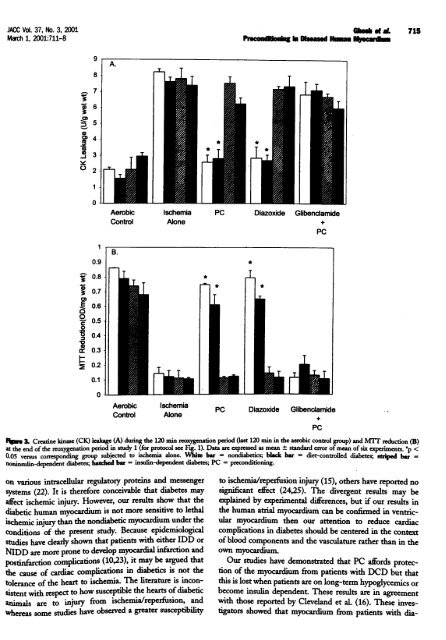ischaemic preconditioning of the human heart. - Leicester Research ...
ischaemic preconditioning of the human heart. - Leicester Research ...
ischaemic preconditioning of the human heart. - Leicester Research ...
Create successful ePaper yourself
Turn your PDF publications into a flip-book with our unique Google optimized e-Paper software.
JACC<br />
Vol. 37, No. 3,2001 Ghosh st aL 715<br />
March 1,2001: 711-8 In Ohmood Nýmnbm<br />
0<br />
3.1<br />
(D<br />
CID<br />
I<br />
10<br />
(D<br />
3:<br />
cm<br />
E<br />
25<br />
0<br />
7S<br />
0.9<br />
0.8<br />
0.7<br />
0.6<br />
0.5<br />
0.4<br />
0.3<br />
0.2<br />
0.1<br />
A.<br />
* *<br />
Aerobic Ischernia PC Diazoxide Glibenclamide<br />
Control Alone +<br />
B.<br />
Aerobic Ischemia<br />
Control Alone<br />
*<br />
PC<br />
PC Diazoxide Glibenclamide<br />
Nowe 3. Creatine kinase (CK) leakage (A) during <strong>the</strong> 120 min reoxygenation period (last 120 min in <strong>the</strong> aerobic control group) and Mrr reduction (B)<br />
at <strong>the</strong> end <strong>of</strong> <strong>the</strong> reox7genation period in StudY 1 (for protocol see Fig. 1). Data are expressed as mean ± standard error <strong>of</strong> mean <strong>of</strong> six oqmiments. *p <<br />
O. o5 versus corresponding group subjected to ischeraia alone. While bar = nondiabetics; black bar = diet-controlled diabeter, striped bar =<br />
nonumlin-4endent diabetes; hatched bar = insulin-dependent diabetes; PC = <strong>preconditioning</strong><br />
on various intracellulu regulatory proteins and messenger<br />
systems (22). It is <strong>the</strong>refore conceivable that diabetes may<br />
affiect ischemic injury. Howem, our results show that <strong>the</strong><br />
diabetic <strong>human</strong> myocardium is not more sensitive to lethal<br />
ischemic injury than <strong>the</strong> nondiabetic myocardium under <strong>the</strong><br />
conditions <strong>of</strong> <strong>the</strong> present study. Because epidemiological<br />
studies have dearly shown that patients with ei<strong>the</strong>r IDD or<br />
NIDD<br />
are more prone to develop myocardial infarction and<br />
(10,23), it<br />
postinfarction complications may be argued that<br />
<strong>the</strong> in diabetics is<br />
cause <strong>of</strong> cardiac complications<br />
not <strong>the</strong><br />
tolerance <strong>of</strong> <strong>the</strong> heat to ischemia. The literature is inconsistent<br />
with respect to how susceptible <strong>the</strong> <strong>heart</strong>s <strong>of</strong> diabetic<br />
ar , Limals are to injury from ischemia/reperfusion, and<br />
whereas some studies have observed a greater susceptibility<br />
PC<br />
to ischemia/reperfusion injury (15), o<strong>the</strong>rs have reported no<br />
significant effiect (24,25). The divergent results may be<br />
explained by experimental differences, but if our results in<br />
<strong>the</strong> <strong>human</strong> atrial. myocardium can be confirmed in ventricular<br />
mYocardium. <strong>the</strong>n our attention to reduce cardiac<br />
complications in diabetes should be centered in <strong>the</strong> context<br />
<strong>of</strong> blood components and <strong>the</strong> vasculature ra<strong>the</strong>r than in <strong>the</strong><br />
own myocardium.<br />
Our studies have demonstrated that PC afords protection<br />
<strong>of</strong> <strong>the</strong> myocardiurn from patients with DCD but that<br />
this is lost when patients are on long-term hypoglycemics<br />
or<br />
become insulin dependent. These results are in agreement<br />
with those reported by Cleveland et al. (16). These investigators<br />
showed that myocardium fiom patients with dia-














